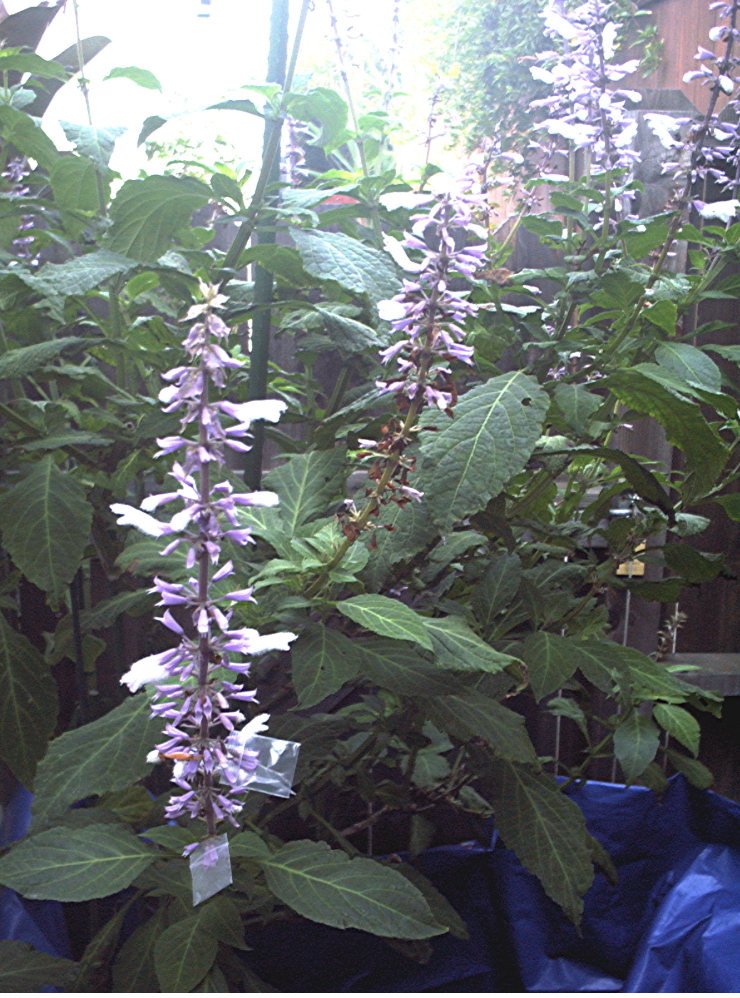
Salvia divinorum also known as Pastora de la Hierba or Ska Pastora often presents herself on trips or in dreams as The Virgin Whore. She sometimes appears as a sexy nun and her world is a world of paradoxes. Though it isn’t necessary to do a full trip with Ska Pastora to work with her medicinal effects, Salvia divinorum is a plant-medicine that’s works getting to know. If you have digestive system issues, she has a proven track record in part because she works to release trauma that has been stored in your digestive system.
Salvia Divinorum for the Digestive System
Salvia divinorum has been used traditionally to treat digestive system disorders such as chronic diarrhea. Digestive system motility, or the movement made by the intestines as food is being digested and passed through it, is altered in a positive way by Salvia. Digestive system inflammation is also reduced by Salvia divinorum in studies examining these effects.
When intestinal inflammation is present, Salvia divinorum is more likely to slow motility and peristalsis of the intestinal tissues. In other words, if you have chronic diarrhea and also intestinal inflammation as well, as from an infection or perhaps irritation of the tissues, Salvia divinorum will help. In studies, the medicinal effects of Salvinorum A on reducing motility is potentiated when the intestines are inflamed. For gut inflammation, Salvinorum A works, at least to some extent, through certain non-kappa-opioid receptor mechanisms that have not been determined yet in addition to its kappa-opioid pain-relieving effects.
Through its kappa-opioid mechanism of action, Salvinorum A has the ability to reduce pain and inflammation without risk of causing addiction. Salvia divinorum, when properly administered, can reduce edema and decrease neutrophil infiltration into tissues that are inflamed throughout the body including in the digestive system. Studies have demonstrated that Salvia divinorum can be useful in the treatment of pain that comes from digestive system issues, neuropathic pain, fibromyalgia pain, and more, but this is an herbal remedy for pain that has relatively short duration of action so when administered as a microdose, it may not have a long-lasting effect in terms of pain-relief. Nonetheless, because Salvia divinorum is a healing herb that releases trauma and stress, over time, it may have longer-lasting, if not permanent healing effects in terms of pain relief if you use it consistently over the course of months or years.
The regulation of colonic function by Salvinorin A in Salvia divinorum isn’t fully understood as yet by scientists. While studies have shown that motility of the colon is slowed, colonic propulsion is prolonged by Salvinorin A. Upper gastrointestinal transit, in contrast is slowed and gastric emptying is unaffected by Salvinorin A. Changes caused by Salvinorin A in terms of colon motility happen mostly through the kappa-opioid receptors as well as interactions between Salvinorin A and cannabinoid receptors (CB1 and CB2).
Salvia divinorum for Intestinal Infection
Salvinorin A can inhibit endotoxin-induced contractions in the colon during an infection via the kappa-opioid receptors and cannabinoid receptors CB1 and CB2. When an infection causes endotoxin-induced changes to neurogenic ion transport in the colon, Salvia divinorum normalizes it through a nitric oxide synthase pathway.
Salvia divinorum as a Sacred Medicine
As a sacred medicine, Salvia divinorum transports people to The Land of the Dead or it promotes novel perspectives in terms of traumatic moments in a person’s life. A person who takes a moderate to high dose of Salvia divinorum may experience themselves as a piece of gum on the sidewalk or as a fresco on a wall in a church (rather than as a human being) to watch a memory that relates to a trauma from the past. In our experience, people will often dissociate into different “soul parts” or sub-personalities (similar to what happens in those with multiple personality disorder / dissociative identity disorder except more integrated than in those who are formally diagnosed with this issue) and some of the sub-personalities are regarded as “evil” or “bad”. Evil or bad sub-personalities / soul parts exist in another realm near the earth-realm where they might embody things like pieces of trash or inanimate objects near the person who cast them off and dissociated from them. In fact these so-called “evil” parts are not evil but they carry really negative emotions from traumas in early life. They’re often very young soul parts that were dissociated before the person with the disease developed language. Salvia divinorum on a full-trip dose gives access to these as well as other soul parts that are not necessarily regarded by that person as “evil”. The goal of working with the sacred medicines like Salvia divinorum in terms of gastrointestinal healing is to integrate the various soul parts and sub-personalities that have been dissociated from the person’s Core Self. When the Core Self bears witness to the soul part’s story – namely the trauma that led to them being dissociated from the Core Self – that soul part can reintegrate and bring its energy with it so as to promote physical healing. Dissociated soul parts often carry very painful emotions that have to felt in the person’s body for integration to occur. Salvia divinorum helps to open the person to feeling these feelings during the trip and observing situations through the eyes and ears of a dissociated soul part.
Kappa-Opioid Pain Therapy Using Salvia Divinorum
The kappa-opioid receptors deal primarily with dysphoric states vs. mu-opioid receptors that deal with the production of euphoric states of being. As an herb that produces dysphoric “trips” that are often very strange and “paradoxical” in terms of content, Salvia divinorum has the potential to “clear” kappa-opioid receptors that may have become host to toxins, chemicals, or even negative emotional states that are causing them to fire at inappropriate times. Rather than producing a euphoric, addictive state as opium and other synthetic opiates do as part of their pain-relief-package, Salvia divinorum produces a state of wise dysphoria that gives the user the opportunity to explore trauma and release it over the course of time. Essentially, those who work with Salvia divinorum for pain-relief doing full-trips confront dysphoric states head-on to eventually overcome them.
Salvinorin A
Big Pharma, has, of course, attempted to produce a synthetic analogue to Salvinorum A. These analogues are toxic though and they contain bioaccumulative ingredients such as bromine that cause damage to the thyroid gland and reproductive organs. Salvinorum A is readily available in the Salvia divinorum whole herb and it produces a significant pain-relieving and inflammation-reducing effect throughout the body, but also in the digestive system. It can be really challenging to reduce inflammation and pain in the digestive system so Salvia divinorum’s digestive system effects are significant. Again though, gastrointestinal pain-relief and inflammation reduction might be short-lived initially, especially when the therapy involves only microdosing. This is a treatment that takes time and consistency, but that could be administered along with other gastrointestinal treatments to heal the body.
Salvia divinorum Dose
Oral Route
Salvia divinorum ceremonies are generally performed at night under dark and quiet conditions. The leaves are chewed in pairs. The juice produced from chewing the leaves are not swallowed but kept in the mouth for about 15 minutes for absorption through the mucus membranes. Once the effects begin and the leaves are swallowed, visions appear. The trip usually lasts less than 2 hours.
A low dose of chewed fresh leaves is 10 grams or 2 grams of dried leaves administered with the leaves in pairs. An average dose is 30 grams of fresh leaves or 6 grams of dried leaves. A high dose is 50 grams of fresh leaves or 10 grams of dried leaves.
Smoking
A few leaves is enough to produce a full-trip under certain conditions, but microdosing is also possible using this method and just a small puff of the smoke. A low dose would be 0.25 grams while an average dose is 0.5 grams of the dried leaves. A high dose is around 0.75 grams of Salvia divinorum.
Infusion
Make an infusion with pairs of leaves according to traditional use. A low dose is 20 pairs of dried or fresh leaves (40 leaves total). An average dose is between 20 to 60 pairs of leaves (40 to 120 leaves total). A high dose is 60 to 80 pairs of leaves (120 to 160 leaves total).
Work with Salvia Divinorum
If you’d like more information about how we work with Salvia divinorum on-site at our facility, contact us at info@medicinassagradas.com. Or, if you’re interested in working with Salvia divinorum to overcome gastrointestinal disease in your home country, contact us to set up a health coaching call. We’ll discuss a protocol for healing that incorporates the use of Salvia divinorum to overcome digestive disorders permanently.

Click here to schedule a health coaching session with us.
Resources:
Wikipedia (2025). Salvia divinorum. Retrieved June 14, 2025 from: https://en.wikipedia.org/wiki/Salvia_divinorum#Traditional_methods
Maqueda, Ana Elda (2018). The Use of Salvia divinorum from a Mazatec Perspective. Retrieved June 14, 2025 from: https://link.springer.com/chapter/10.1007/978-3-319-76720-8_4
N.A. (2020). Microdosing the Hell: Salvia divinorum. Retrieved June 14, 2025 from: https://erowid.org/experiences/exp.php?ID=114182
Hanes, Karl R. (2001). Antidepressant Effects of the Herb Salvia Divinorum: A Case Report. Retrieved June 14, 2025 from: https://www.erowid.org/plants/salvia/salvia_journal3.shtml
Brito-da-Costa, Andreia Machado, et. al. (2021). Pharmacokinetics and Pharmacodynamics of Salvinorin A and Salvia divinorum: Clinical and Forensic Aspects. Retrieved June 16, 2025 from: https://www.mdpi.com/1424-8247/14/2/116
Fichna, J. et al. (2009). Selective natural kappa opioid and cannabinoid receptor agonists with a potential role in the treatment of gastrointestinal dysfunction. Retrieved September 24, 2025 from https://pubmed.ncbi.nlm.nih.gov/19890495/
Fichna, J. et al. (2011). Differential effects of salvinorin A on endotoxin-induced hypermotility and neurogenic ion transport in mouse ileum. Retrieved September 25, 2025 from https://pubmed.ncbi.nlm.nih.gov/21414104/
Fichna, J. et al. (2009). Salvinorin A inhibits colonic transit and neurogenic ion transport in mice by activating kappa-opioid and cannabinoid receptors. Retrieved September 25, 2025 from https://pubmed.ncbi.nlm.nih.gov/19650775/
Capasso, R. et al. (2008). The hallucinogenic herb Salvia divinorum and its active ingredient salvinorum A reduce inflammation-induced hypermotility in mice. Retrieved September 24, 2025 from https://pubmed.ncbi.nlm.nih.gov/17931335/
Capasso, R. et al. (2006). The hallucinogenic herb Salvia divinorum and its active ingredient salvinorin A inhibit enteric cholinergic transmission in the guinea pig ileum. Retrieved September 25, 2025 from https://pubmed.ncbi.nlm.nih.gov/16371085/
